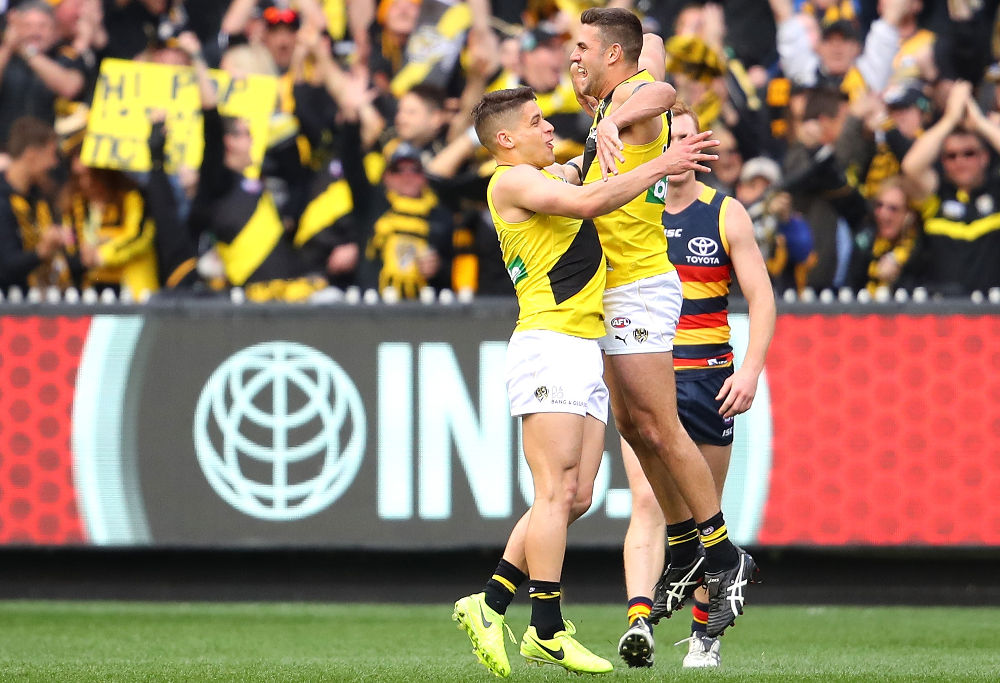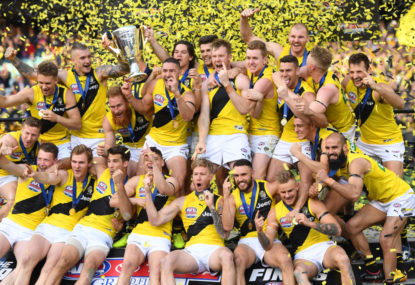The old adage that a champion team will always beat a team of champions has never rung truer than in the aftermath of Richmond’s 2017 AFL premiership.
At no stage through the season were the Tigers ever really seen as a genuine top four side, let alone a legitimate premiership threat.
Adelaide were generally considered to be the best team across the season. The talent at GWS was never far from the conversation. A number of people had doubts about Geelong, but they were still seen as around the mark for most of the year. Port produced some dominant wins in the first half of season to put themselves in the frame. Across the last 17 weeks of the home and away rounds, Sydney were clearly the standout performer.
All the while, Richmond kept plugging along. The wins kept coming, mostly seen to be off the back of a friendly draw thanks to a 13th-placed finish last season.
There were some losses too. Thumped by the Crows in Adelaide. Deplorable against Fremantle at the ‘G. Stupendously awful against St Kilda at Etihad.
Then there were the chokes. Six goals up against each of Western Bulldogs, Sydney and GWS, but couldn’t win a one of them.
Three very bad performances. Three games they should have won easily. Looking back now, we can see that in those humiliations was born a steely resolve.
Richmond won four in a row after losing to St Kilda in Round 16, with the best being the last of them, against a Hawthorn side in very good form and holding onto finals hopes.
Going down at Simonds Stadium in Round 21 was the loss they had to have. The Tigers started favourites in that game due to the Cats being without Joel Selwood, Mitch Duncan and Tom Hawkins, and it was the last reminder they needed to take nothing for granted and only their best would do come September.
In their last five matches of the season, Richmond averaged 116 points per game, while keeping their opposition to an average of 60. That’s an average winning margin of 56 points, including matches against the sides that finished first, second and fourth on the ladder.
As someone on Twitter put it, the Tigers bludgeoned their way to a flag, being lower, harder and stronger for longer against all their opposition through September.
Richmond led by nine points at halftime against Geelong, one point at halftime against GWS, and nine at halftime against Adelaide. They won those games by 51, 36 and 48 points respectively, outscoring their opposition by a total of 116 points in second halves as their relentless pressure took its toll.
This was a premiership for the team above all else, a flag for the no-frills, no-name, role players that populate the Tiger line-up, which complement the big four of Dustin Martin, Alex Rance, Trent Cotchin and Jack Riewoldt.
Jack Graham polled a Norm Smith vote as a 19-year-old in only his fifth game. The youngest player on the field was sent to quell the first quarter’s best player, competition gun Rory Sloane. Graham is a footballer’s footballer, sure of hand, composed in his decision-making, and possessed with a good footy brain.

(Photo by Cameron Spencer/AFL Media/Getty Images)
Nathan Broad was a mature-age recruit and now has an AFL premiership after 12 games as a 24-year-old. He kept the important Tom T Lynch to finals series lows for all the key stats, and was always there to lay an important tackle or put the ball into the hands of a teammate in a better position, one of only four players on the day to not record a clanger.
Many clubs have a back pocket stopper that is under-appreciated outside their own club, courageous, hard, never beaten. Dale Morris is a legend of this sort of position, and Dylan Grimes is in the same mould – quick, nimble, smart, able to play tall or small. Grimes kept Eddie Betts to seven disposals, which is an equal low for his time at Adelaide.
Staying down back, David Astbury produced All Australian football at full-back in 2017, but without the All Australian name. It takes observers a long time to catch up on defenders. Astbury played 24 games in five seasons between 2011-15, but has now established himself as second-in-command behind Alex Rance in the key defensive post at Richmond.
Kamdyn McIntosh is the country boy with the incredible work and life ethic, growing up putting family members before himself, and now plays footy in the same spirit. He played the members wing all day against a series of opponents, and never let up with a physical and verbal barrage against any that came near him. His stats weren’t big, but his presence was large, and he was leader in creating a hostile and unwelcoming environment for the Crows.
Jacob Townsend is the archetypal football battler, never good enough to play more than 11 games in a season in six years on AFL lists at GWS and Richmond. Before breaking into the Tiger line-up in Round 22, he had played five of a possible 69 matches at AFL level.
Yet Townsend, like his teammates, embodied the Richmond spirit across the last five weeks – do your job, trust your teammates to do theirs, help them out when you can, hit hard, hit often, kick truly when the chance arrives. Townsend’s role was to quell the influence of the opposition’s most dangerous intercept backman, something he did to all of Lachie Henderson, Nick Haynes and Jake Lever across the finals.
A mature age rookie that forced his way onto the senior list, Kane Lambert was arguably Richmond’s most consistent player across the 12 quarters of finals football the club played. He ran harder and longer than any teammate or opponent he came across in September, winning inside and outside ball, clearances, laying tackles, applying pressure, kicking goals and setting them up.
Toby Nankervis was fourth banana in the ruck position at Sydney in 2016, and finishes 2017 as the premiership ruckman. He’s not the tallest, strongest or most mobile out there, but he is the fiercest competitor, which was the foremost focus of Richmond’s surge to glory. Whether on the ground following up at a stoppage, repelling opposition attacks in the air, Nankervis was another to epitomize the unstoppable work ethic that flowed through his team.

(Photo by Daniel Kalisz/Getty Images)
Last but not least of the no-name brigade were the Tiger small forwards, Dan Butler and Jason Castagna, players of little height but that grew in stature the longer the season went. It’s impossible to separate what they brought to the team in 2017 after having played five games between them heading into this season.
Speed and pressure were their two fundamentals throughout the year, and were another example of the narrow focus that the Richmond coaches asked of their players, trusting their natural abilities to take care of the rest. Butler and Castagna incited panic in the opposition when looking to tackle, but also when they had the ball, bursting forward and leaving defenders flat-footed.
Richmond may not have had the most talented players to take the field across September, but they were the best team, in the true sense of the word. It was led from the top down. It was delivered from the bottom up.
A lot of people were disappointed by a finals series that didn’t deliver enough close games. The Tigers weren’t involved in any, because they didn’t allow their opposition to play anywhere near their best.
In the grand final, it was impossible for both teams to play well.
If Adelaide played well, it meant Richmond hadn’t. If Richmond played well, it meant Adelaide couldn’t. As we know, Richmond played well.
The big name Tigers certainly did their bit. The unheralded Tigers more than delivered. Together, they made Richmond a champion team.































































































